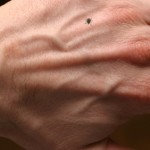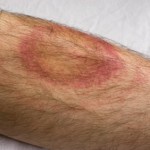I'm finally ready to write about Lyme disease and will start with the basics; it results from the bite of a tiny tick and causes well over 20,000 cases per year in the US. It's most common in the North-East and the Middle-West, most frequently affects kids under 16 (especially girls--ticks can hide in long hair) and can be prevented (DEET to keep ticks away; post-hike "tick checks"); prompt antibiotic treatment is indicated if signs or symptoms/history suggest this entity.
I'll save the controversy about post-treatment Lyme disease syndrome, AKA Chronic Lyme Disease, for another post as that issue deserves its own discussion.
We first heard about Lyme disease some years back when a relative was afflicted by a severe case of the illness. One of the best resources I've subsequently found on Lyme came from an emeritus at the place I got my formal medical training, the University of Wisconsin, now termed UW-Madison. Dr. Kenneth Todar, a PhD in the Department of Bacteriology, has a superb online textbook and his chapter on Lyme Disease is an extremely helpful reference.
The initial realization of the disease itself happened thirty-seven years ago. The website for NIAID, the National Institute of Allergy and Infectious Diseases has a great, though somewhat convoluted, detailed history of Dr. Willy Burgorfer's isolation of the spirochete bacteria that would eventually be named for him.
In brief, there had been a 1975 outbreak that resulted in a considerable number of children living in or near the town of Lyme, Connecticut, being diagnosed with juvenile rheumatoid arthritis. The Yale physician looking for the cause of these Lyme disease cases realized most occurred in children who spent time in wooded areas and whose initial symptoms occurred in the midst of the tick season, summer. He thought the deer tick might be involved and, eventually, Dr. Burgdorfer found the spirochetes in deer ticks sent to him from the affected area.
IDSA, the Infectious Disease Society of America, has a one-pager titled "Ten Facts You Should Know About Lyme Disease" and the New York Health Department has a similar short discussion of Lyme Disease.
To reiterate the concepts I think are crucial: the groups involved, kids under 16 with more girls than boys, plus adult men;. the areas of the country: 93% of cases occur in ten states: Connecticut, Delaware, Maryland, Massachusetts, Minnesota, New Jersey, New York, Pennsylvania, Rhode Island and Wisconsin; the fact that early diagnosis is clinical (antibodies develop later); the tiny size (two mm) of the tick nymphs which usually are the agents for transmission of the bacteria; the difficulty in diagnosis unless the characteristic rash is present; and the need for prompt antibiotic treatment in prevention.
Symptoms begin to show anywhere from a few days to a month after the bite, but, in most cases, the tick itself has to remain attached for a day and a half to transmit the bacteria and there is no person to person spread of this disease. Early signs, in the absence of the characteristic rash, are very non-specific.
There is a sizable percentage of patents with Lyme who have long-term sequelae. I'll write about them next time.
Tags: Lyme Disase, spirocetes, tick-borne diseases


